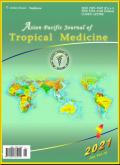Hearing loss and tinnitus associated with COVID-19 vaccines: An analysis from the national pharmacovigilance database in Malaysia
IF 1.6
4区 医学
Q3 PUBLIC, ENVIRONMENTAL & OCCUPATIONAL HEALTH
引用次数: 0
Abstract
To compare the reporting pattern of hearing loss and tinnitus across different vaccines brands used in Malaysia (BNT162b2, CoronaVac, ChAdOx1, Ad5.CoV2-S and BBIBP-CorV). This retrospective study included all reports of hearing loss and tinnitus occurring after COVID-19 vaccination that were received in the national pharmacovigilance database, QUEST, from February 24, 2021 through July 31, 2022. Reports given causality consistent or indeterminate were included. There were 21 cases of hearing loss, with overall reporting rate of 0.29 cases per million doses. The rate was similar across BNT162b2, CoronaVac and ChAdOx1. For tinnitus, 35 cases were reported, with the overall reporting rate of 0.49 cases per million doses, and the highest rate was reported for ChAdOx1. For both events, most cases aged 30 to 49 years. No gender disparity was observed. Both events were mainly reported to have occurred after the primary doses, with a median time-to-onset of two days. There were no statistically significant differences in the reporting patterns for both events across BNT162b2, CoronaVac and ChAdOx1 by age group, gender, race, and dose number. Despite the low reporting rates and insufficient evidence to confirm its relationship, hearing loss and tinnitus following vaccinations should not be ignored due to its disabling potential and impact on one's quality of life. Continual reporting is encouraged for better signal characterization in the future.与COVID-19疫苗相关的听力损失和耳鸣:来自马来西亚国家药物警戒数据库的分析
比较马来西亚使用的不同疫苗品牌(BNT162b2、CoronaVac、ChAdOx1、Ad5)的听力损失和耳鸣报告模式。CoV2-S和BBIBP-CorV)。这项回顾性研究纳入了2021年2月24日至2022年7月31日期间国家药物警戒数据库QUEST中收到的所有COVID-19疫苗接种后发生的听力损失和耳鸣报告。包括因果关系一致或不确定的报告。有21例听力损失,总体报告率为0.29例/百万剂量。BNT162b2、CoronaVac和ChAdOx1的感染率相似。对于耳鸣,报告了35例,总体报告率为0.49例/百万剂量,其中ChAdOx1报告率最高。对于这两种情况,大多数病例年龄在30至49岁之间。没有观察到性别差异。据报道,这两种事件主要发生在初次给药后,中位发病时间为2天。在BNT162b2、CoronaVac和ChAdOx1中,两种事件的报告模式按年龄组、性别、种族和剂量数没有统计学上的显著差异。尽管报告率很低,证据也不充分,但接种疫苗后听力损失和耳鸣不应被忽视,因为它可能会致残,并影响一个人的生活质量。鼓励持续报告,以便将来更好地表征信号。
本文章由计算机程序翻译,如有差异,请以英文原文为准。
求助全文
约1分钟内获得全文
求助全文
来源期刊

Asian Pacific journal of tropical medicine
PUBLIC, ENVIRONMENTAL & OCCUPATIONAL HEALTH-TROPICAL MEDICINE
CiteScore
4.00
自引率
9.70%
发文量
1936
审稿时长
3-8 weeks
期刊介绍:
Asian Pacific Journal of Tropical Medicine (ISSN 1995-7645 CODEN: APJTB6), a publication of Editorial office of Hainan Medical University,is a peer-reviewed print + online Monthly journal. The journal''s full text is available online at http://www.apjtm.org/. The journal allows free access (Open Access) to its contents and permits authors to self-archive final accepted version of the articles on any OAI-compliant institutional / subject-based repository.
APJTM aims to provide an academic communicating platform for international physicians, medical scientists, allied health scientists and public health workers, especially those of the Asia-Pacific region and worldwide on tropical medicine, infectious diseases and public health, and to meet the growing challenges of understanding, preventing and controlling the dramatic global emergence and re-emergence of infectious diseases in the Asia-Pacific.
The journal is proud to have an international and diverse editorial board that will assist and facilitate the publication of articles that reflect a global view on tropical medicine, infectious diseases and public health, as well as emphasizing our focus on supporting the needs of public health practitioners. The APJTM will allow us to seek opportunities to work with others who share our aim, and to enhance our work through partnership, and to uphold the standards of our profession and contribute to its advancement.
 求助内容:
求助内容: 应助结果提醒方式:
应助结果提醒方式:


